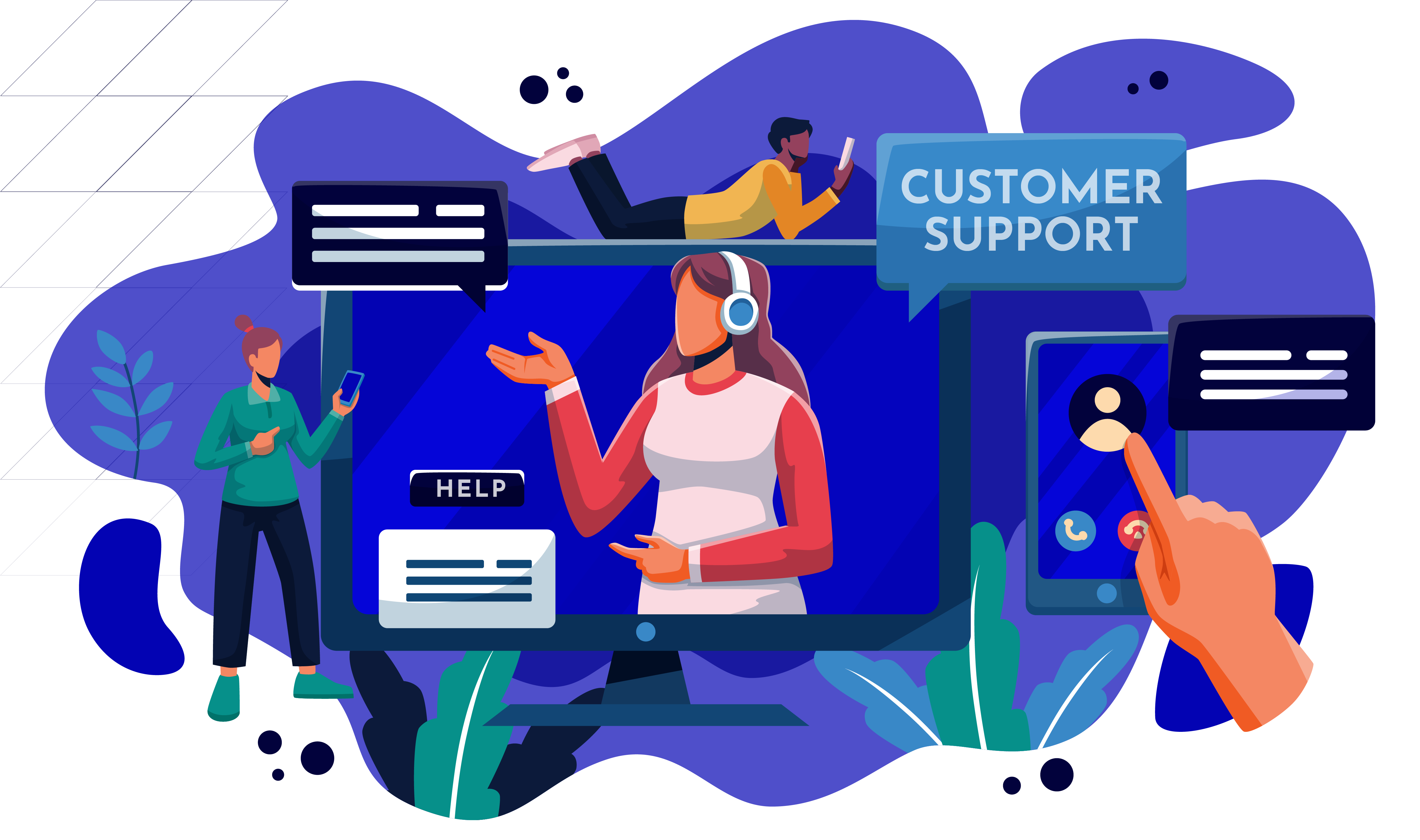A customer care business plan is a structured guide. It defines how a company will support customers before, during, and after a sale. For consumer brands and D2C companies across the US, UK & Australia, such a plan ensures service consistency and stronger customer retention.To make this plan, you first need to set service goals and map the customer journey. Next, define processes, choose the right tools and train your staff. The plan ensures consistent support across all touchpoints.
You: “Who’s handling the refund request from yesterday?”
Your agent: “I thought Mrs. Z was on it.”
You: “No, she said it’s not her job. The customer has called twice already.”
Sound familiar? Many businesses face this kind of confusion daily! Do you know why?
- Lack of clear processes
- No accountability
- Improper delegation of duties
- No way to track what’s working or failing!
The solution? A well-documented customer care business plan. It brings accountability, role clarity and performance visibility across every interaction. Also, it defines workflows that let your support team respond to customers in minimal time
So, want to avoid the daily chaos? Keep reading to learn how to design a customer care plan that boosts CX, efficiency and long-term loyalty.
What is a Customer Care Business Plan?

A customer care business plan (also known as a customer service strategy) is a roadmap that shows how your business will support customers before, during, and after a purchase. Primarily, it explains:
- How should your team treat customers?
- How should they answer their questions?
The goal is to make sure every customer feels respected and taken care of.
Furthermore, this plan covers the omnichannel messaging solutions you can offer, such as phone, email, or chat. Basically, in a customer care business plan, you decide what kind of service you want your business to provide and how your team will deliver it.
Make Your Customer Service Business Plan in 2025! Step-by-Step Guide

Did you know? US companies lose $75 billion yearly due to poor customer service. This largely happens because about 73% of consumers switch to a competitor after multiple bad experiences.
However, by building a data-driven customer care business plan, you can understand the real needs of your customers and then design your services to meet those needs.
Be aware that the strategy must cover the entire customer journey. This means you must start from the time they first hear about you to after they make a purchase. Your service plan should cover all those steps.
Below is a step-by-step guide you can follow to make a customer service business plan:
Customer Care Business Plan Step 1: Define Clear Customer Service Goals

Start by deciding what your customer service team should achieve. Some common examples are:
- Shorter wait times for replies
- Lower call abandonment rate
- Low churn rate, and more
Ideally, you should set goals that are easy to understand and measure. To do this, follow the “SMART” method. As per this technique, your goals should be:
| SMART Technique Parameters | Meaning |
| Specific | Clearly state what you want to improve. |
| Measurable | Track progress with numbers |
| Achievable | Set goals your team can reach |
| Relevant | Only focus on action items that truly matter for your business |
| Time-bound | Set realistic deadlines |
Always remember that without goals, your team may work hard but not know what they are trying to improve.
At Atidiv, we’ve helped clients achieve 80% time savings and 50% cost reductions by setting measurable CX goals and tracking KPIs like FCR, CSAT and AHT. Read the full case study.
Customer Care Business Plan Step 2: Identify Your Target Audience and Develop Customer Personas

To support customers the best, you must know who they are! You should develop an understanding of:
- Their real needs
- The problems they face
- How they prefer to interact with your business
For example, CX leaders managing consumer brands often segment their audience by behavior, purchase frequency and channel preference.
To do so, create customer profiles (called personas). These personas describe different types of customers. A persona includes:
- Age
- Job type
- Interests
- Goals
- Common issues the customer may have.
For example,
- Say one persona might be a busy parent who shops online and wants quick answers.
- Another could be a small business owner who values detailed product support.
By understanding these differences, you can create service methods that work for each group. This step lets your team give better support because they know what each type of customer is looking for. This approach helped Atidiv’s clients improve customer satisfaction scores by 20–30% in under six months. Explore how.
Customer Care Business Plan Step 3: Map the Customer Journey

The customer journey is the full experience a person has with your business. It starts from first learning about you and stops at getting support after a purchase.
While making a customer care business plan, start by listing all the steps a customer takes:
- Visiting your website
- Asking questions
- Placing an order, and so on.
Then, look at each step and ask:
- Is anything unclear or frustrating for the customer?
- Are there delays or missed opportunities to help them?
This will show where improvements are needed. You can also use a simple visual chart to see the flow. This will allow your team to understand how their work fits into the customer’s full experience.
Mapping the journey highlights friction points and helps you align tools, teams and training around real customer touchpoints.
Customer Care Business Plan Step 4: Develop Customer Service Processes and Workflows
Your team needs clear steps to follow when helping customers. Thus, you must write down what should happen when someone:
- Calls
- Sends an email
- Shares a complaint
Also, decide who handles which tasks. For example,
- Say, one person might handle returns
- Another might answer product questions
By assigning clear roles in a customer care business plan, you can avoid confusion and ensure your customers get answers in the minimum time. Furthermore, when processes are written down, training becomes easier and service stays consistent. Everyone knows what to do, even when things get busy or stressful!
Atidiv often implements standardized workflows for D2C brands, reducing average resolution time by up to 35%. See how.
Customer Care Business Plan Step 5: Select Tools and Technologies
In this step, you must choose tools that allow your team to manage customer questions and solve their problems. Some common tools are:
- AI-powered customer support
- Help desk software
- Live chat service for websites
- Customer databases (CRMs), and more
By using these tools, you can smartly track each customer’s history, so your team doesn’t have to ask the same questions every time. Ideally, pick systems that fit your business size and service needs, especially if you are considering IT helpdesk outsourcing to scale support efficiently. Don’t choose a tool just because it’s popular!
The right toolset depends on your company size and goals. For mid-sized consumer brands ($5M+ revenue), automation and CRM integration can save hundreds of hours monthly.
Next, train your team on how to use each tool. Remember, your goal is to make it easier for your team to:
- Talk to customers
- Solve issues
- Follow up
Customer Care Business Plan Step 6: Track KPIs
To understand how good your customer service is, you should track popular performance indicators (known as KPIs). In this step, you can start tracking the following:
| KPIs to Track | Purpose |
| Customer Satisfaction Score (CSAT) | A score based on how happy customers are after an interaction. |
| Net Promoter Score (NPS) | A number that shows how likely a customer is to recommend your business. |
| First Response Time (FRT) | It shows how long it takes to reply to a customer. |
| Customer Effort Score (CES) | A rating of how easy it was for the customer to get help. |
Also, collect feedback directly from customers. You can send short surveys after every support interaction or ask for reviews. Check these regularly and look for patterns. Linking these KPIs with your customer care plan helps you spot issues early and measure ROI.
Customer Care Business Plan Step 7. Implement Training and Continuous Improvement Plans (CIPs)
Your customer service team must be trained to handle products, systems, and people. This training is not a one-time task! Your customer service business plan must have scope to regularly train staff on:
- Communication skills
- Problem solving
- Product knowledge
- How to handle complaints
Additionally, track their performance over time. If someone is struggling, offer more training. Always remember – better training leads to better service, fewer mistakes, and more customer trust!
Atidiv implements Continuous Improvement Programs (CIPs) to track performance, identify skill gaps, and deliver micro-training. In one engagement, this approach helped maintain 95%+ quality scores for a high-volume aggregator. See case study.
Customer Care Business Plan Step 8: Document Policies, Procedures, and Escalation Paths
You must write clear rules and instructions for your customer service team to follow. Your customer care business plan should cover how to handle:
- Refunds
- Returns
- Complaints
- Delays
Also, explain what to do if a team member cannot solve a problem. This is called an “escalation path.” It shows who to pass the issue to and how. For example, say a team member forwards a case to a manager if the issue is serious. Documenting escalation paths ensures accountability and reduces confusion during high-volume periods.
Customer Care Business Plan Step 9: Promote Cross-Department Collaboration
Customer service should not work alone! Your support team must stay in contact with:
- Sales
- Marketing
- Product teams
That’s because each group sees different sides of the customer experience. When they share what they know, it significantly reduces customer resolution times.
For example,
- Say many customers are confused by a product feature.
- Now, the support team can tell the product team to improve it.
- Or, if a sale leads to many questions, marketing can update how the product is described.
Ideally, your customer care business plan should have provisions for setting up regular meetings. Also, they should periodically share status reports. Collaboration improves CX alignment and helps identify recurring customer pain points faster.
Customer Care Business Plan Step 10: Review and Update the Plan Regularly
What worked last year may not work today! That’s because:
- Your customer’s needs change
- Tools change
- Your business goals also change
So, your customer care business plan should also be updated on a regular schedule, ideally, every 3, 6, or 12 months.
To make smart changes, you should ask yourself:
- Are our goals still right?
- Are our tools helping or causing delays?
- What new feedback have we received?
- What problems have come up more than once?
Use the answers to make updates. Don’t forget to involve your team in the review! They work with customers every day and know what needs to be improved. Regular reviews future-proof your service strategy and ensure adaptability in dynamic markets like eCommerce and consumer brands.
Too Many Steps? Let Atidiv Handle It, Start to Finish!
By creating and implementing a strong customer service business plan, you can significantly improve CX, sales, and ultimately profits! Some common steps you can perform are:
- Setting clear goals
- Mapping customer journeys
- Selecting the right tools
- Training your team
- Tracking performance
Remember, each step demands planning and consistency! Finding it hard? Drop the hassle!
Atidiv is a CX specialist digital customer experience partner that can handle the entire process for you. Atidiv tracks at least 10 core call centre metrics, which cover standard KPIs like AHT, FCR, and CSAT, as well as advanced analytics like XQI and topic modelling.
Our expert team uses AI to automate repetitive tasks like ticket tagging and routing. With Atidiv’s omnichannel messaging solutions (email, chat, SMS, and social media), your customers receive consistent and professional support on every platform.
Our solutions deliver measurable outcomes:
- 80% time savings and 50% cost reduction for a startup
- $20M+ in savings with 95%+ quality for a global aggregator
- Up to 65% employee cost savings for a media client
Leave customer care management to us. Hire Atidiv today and turn customer support into loyalty-building moments!
We’re built for scale, driven by data and proven by results.
FAQs On Customer Care Business Plan
1. I operate on a small scale. Should I make a customer service business plan?
Yes! Without a clear plan, your team won’t know how to handle customer problems or measure success. A business plan gives structure. It avoids confusion and ensures customers get the right help every time.
2. How do I know if my current customer service is working?
You can track key metrics like:
- Response time
- Satisfaction scores
- Repeat complaints
- First call resolution rates, and more
If customers often follow up or leave unhappy, something needs to change! By analysing regular feedback and major KPIs, you can easily identify the weak areas. If customer follow-ups are frequent or feedback is negative, your plan needs improvement.
3. What tools should I choose for my business?
Pick tools as per your business size and budget. They must match your customer volume and service needs. Try to avoid expensive platforms you won’t fully use!
As a recommendation, go for providers that offer flexible pricing. Start simple with live chat, CRM and helpdesk tools, they are often enough for mid-sized companies.
4. How can I keep my service consistent as my business grows?
Make a detailed customer care business plan by writing down service processes. Next, train your team regularly and update your plan as needed. Also, use software that grows with you!
Alternatively, outsource CX to Atidiv for up to 60% cost savings and 24/7 support coverage.

